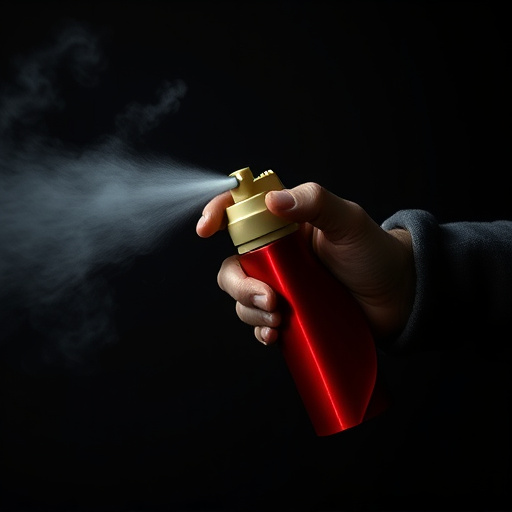Riot control agents, governed by global legal frameworks, balance public safety and risk. Strongest legal pepper spray ingredients, like capsaicin, amyl nitrate, and oleoresin capsicum, deliver potent effects but carry health risks. Strict regulations, including training, protocols, and ingredient standards, ensure responsible use while mitigating harm during civil unrest. Future law enforcement strategies focus on advanced, targeted non-lethal interventions to minimize risk for both suspects and officers.
Riot control agents, particularly pepper spray, have become integral tools for law enforcement worldwide. This article delves into the legal frameworks governing these powerful substances, exploring the chemical composition of the strongest legal pepper spray ingredients commonly used. We balance effectiveness and safety concerns, examine international regulations, and consider future trends that may enhance or replace traditional methods in riot control.
- Understanding Riot Control Agents: Legal Frameworks
- Common Ingredients in Pepper Spray for Law Enforcement
- Effectiveness and Safety Concerns: A Balancing Act
- International Regulations: Global Perspectives on Pepper Spray
- Future Trends: Enhancing or Replacing Traditional Methods?
Understanding Riot Control Agents: Legal Frameworks
Riot control agents, often referred to as less-lethal weapons, are chemical substances designed to disrupt and disperse crowds during civil unrest or large gatherings. The legal frameworks surrounding their use are stringent, with each country implementing regulations to ensure responsible deployment. These laws typically classify riot control agents based on their potency, focusing on the strongest legal pepper spray ingredients available.
The primary concern is to balance public safety with the potential risks associated with these chemicals. Legal requirements often mandate specific training for law enforcement officers using such agents, detailed protocols for their application, and strict conditions for storage and disposal. Understanding these legal frameworks is crucial for both law enforcement agencies to adhere to the rules and citizens to know their rights and protections during situations involving riot control measures.
Common Ingredients in Pepper Spray for Law Enforcement
Pepper spray, a staple in law enforcement riot control kits, is designed to temporarily incapacitate individuals through irritation and pain. The primary active ingredient in most pepper sprays is capsaicin, derived from chili peppers. However, manufacturers often combine various compounds to create what they claim as the strongest legal pepper spray ingredients. These formulations can include amyl nitrate, oleoresin capsicum (OC), and various other chemicals like piperine and isothiocyanates.
The strength of pepper spray is measured in capsaicoid units (CU), with higher CU indicating greater potency. Amyl nitrate, for instance, offers a quick but potent release of heat and irritation. OC, on the other hand, provides a more sustained effect. Combining these ingredients allows for a balanced spray that delivers both immediate impact and lasting discomfort, making it an effective tool in law enforcement scenarios.
Effectiveness and Safety Concerns: A Balancing Act
Riot control agents, including pepper spray, have long been a cornerstone of law enforcement strategies for crowd management and disorder control. While these tools prove effective in de-escalating tense situations and protecting both officers and civilians, their use also raises significant safety concerns. The balancing act lies in selecting the right agent with optimal effectiveness while minimizing health risks to users and bystanders.
One key consideration is the potency of the ingredients, particularly when it comes to the strongest legal pepper spray ingredients. Capable of temporarily blinding and incapacitating individuals, these powerful substances demand precise application and training to ensure their safe use. Law enforcement agencies must invest in proper equipment, ongoing training programs, and clear protocols to mitigate the risks associated with riot control agents, ensuring public safety remains a top priority.
International Regulations: Global Perspectives on Pepper Spray
International regulations play a crucial role in governing the use and availability of riot control agents, including pepper spray. While specific laws vary across countries, many share a common goal of ensuring public safety while allowing law enforcement agencies the tools they need to maintain order during civil unrest or high-risk situations. The global perspective on the strongest legal pepper spray ingredients is one of careful consideration and stringent standards.
Regulators worldwide have implemented strict guidelines for the composition and potency of pepper spray, aiming to balance effectiveness in crowd control with minimizing harm to bystanders and individuals who may not be the intended targets. These regulations often dictate factors like capsaicin concentrations, delivery systems, and training requirements for officers. As a result, law enforcement agencies must adhere to international standards, ensuring that their chosen riot control agents are both safe and effective in diverse cultural and legal landscapes.
Future Trends: Enhancing or Replacing Traditional Methods?
The future of riot control and law enforcement strategies is a topic of great interest, with a growing emphasis on non-lethal weapons and de-escalation techniques. While traditional methods like batons and tear gas have been effective, there’s a push to explore innovative solutions, especially as public interactions become more complex. One area of focus is the development and adoption of advanced riot control agents, aiming to enhance or even replace conventional options.
Researchers are delving into the potential of stronger legal pepper spray ingredients, aiming to create formulations that offer superior effectiveness while minimizing harm to both suspects and officers. The goal is to strike a balance between crowd control and individual safety, ensuring that law enforcement has the tools they need for diverse scenarios without resorting to lethal force. This evolution in tactics reflects a broader trend towards more sophisticated and targeted non-lethal interventions.
Riot control agents, particularly pepper spray, are powerful tools for law enforcement but come with significant safety and effectiveness considerations. As we’ve explored, understanding the legal frameworks governing these substances is crucial, while international regulations provide a global perspective on their use. Moving forward, the balance between enhancing current methods or exploring replacements remains a key focus, especially regarding the strongest legal pepper spray ingredients. Ultimately, striking the right balance ensures that law enforcement has effective tools while safeguarding public safety and civil liberties.
